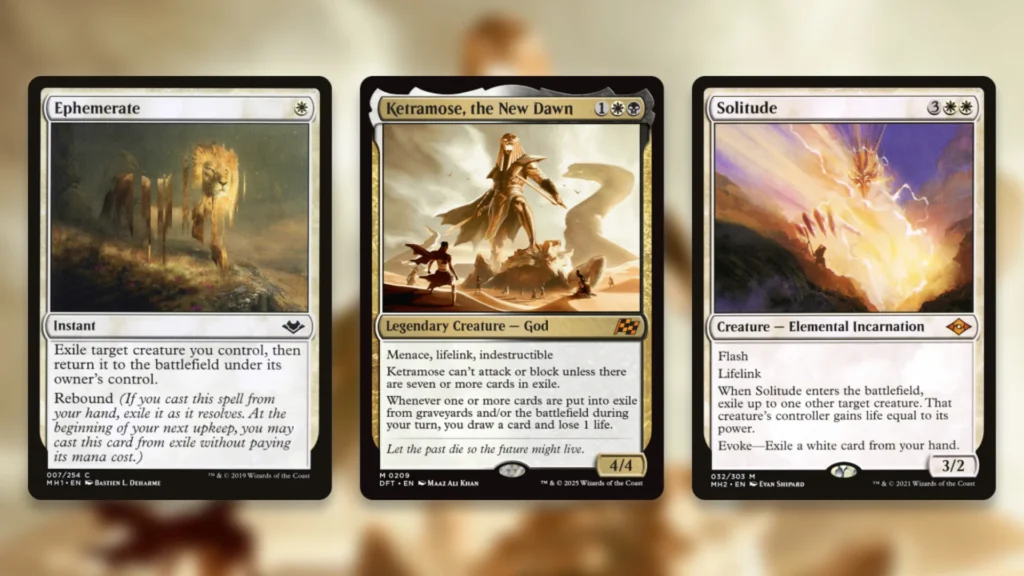While Magic: The Gathering’s Standard players scramble to make sense of the new format in the wake of yesterday’s devastating bans, Modern players have woken up to a world unchanged. We’ve known there would be no Modern bans in this update since April, and Wizards stuck to their promise yesterday. That said, Modern is by no means static right now.
We’ve seen some truly innovative brews in the format recently, and some new Final Fantasy cards have found unexpected homes. Joining this esteemed roster, a Grixis Goryo’s Vengeance deck took down an MTG Online Modern League yesterday.
Goryo’s Vengeance is a time-honored archetype in Modern, but players typically build it in Esper colors. A Grixis take on the deck is a bold experiment in that regard. On top of that, this list also spotlights one of the chunky new legends from Final Fantasy, marking its first real non-Commander appearance since launch. There’s a lot to unpack here, all of it exciting. Looks like Modern doesn’t need bans to inspire player creativity.
Sin, Spira’s Punishment In Grixis Goryo’s Vengeance MTG

This spicy Grixis take on Goryo’s Vengeance comes to us via MTG player TrueHero. They took the list above to a 5-0 finish in yesterday’s MTGO Modern League. For the most part, the core ideas of classic Goryo’s Vengeance remain intact here. You want to get a big legend into your graveyard, reanimate it with the titular instant, and ride that huge value wave to victory.
The big legends in question tend to be Atraxa, Grand Unifier and Griselbrand, and they retain their spots in TrueHero’s list too. Both offer an absurd amount of card advantage as soon as they come down. Both can also gain you a bunch of life as they swing in with Lifelink, thanks to the Haste from Vengeance. These two are the best reanimation targets in most formats, Modern included.
Where TrueHero deviates from the norm is in the addition of another reanimation target to the deck: Sin, Spira’s Punishment. Sin is essentially a reanimation spell that you want to reanimate, ‘bringing back’ permanents from your graveyard on entry and attack. If you can keep your graveyard small, just your other big creatures and lands, then Sin can provide some huge value for the deck.
Even better, bringing your big creatures back via Sin avoids the ‘exile at end of turn’ problem Vengeance normally imposes. Your legends will be tokens, which makes them vulnerable to bounce spells, but you’ll likely still get more value out of them than normal. On top of that Sin is just another seven-power evasive body for the deck, helping apply the pressure needed to win. It’s rare that a new face joins the reanimator ranks, but Sin certainly seems to have the stuff.
Better Red Than Dead

The deck’s other big innovation, perhaps even more so than Sin, is the switch from Esper to Grixis. Changing white for red totally mixes up the makeup of the deck, allowing for new lines while removing some others.
For starters, red lets the deck run a full playset of Faithless Looting. This is one of the best discard outlets in the game, and was kept out of Modern for years until December’s unbans. In this deck, it serves as a way to find your reanimation targets and dump them into the ‘yard at a low cost. The Flashback won’t come up too often, but it’s a nice bonus in the games where it does. Traditional Goryo’s Vengeance decks run the much worse Faithful Mending in the same role, so it’s nice to have access to the real deal in Grixis.
The other big addition to the Grixis list is Fable of the Mirror-Breaker. This is another once-banned card, in Standard anyway, and it serves a number of functions here. First of all, it provides a body on the board with the Goblin Shaman token, and some ramp/fixing via the Treasures it creates. The second chapter is another Faithless Looting if you need it, and the back side is a nice way to copy some of your smaller creatures. Getting a hasty Psychic Frog can be huge to push through damage. Alternatively, copying Emperor of Bones can give you more access to your graveyard if you haven’t drawn Vengeance yet.
Outside of this pair, the switch to Grixis mainly affects the deck’s sideboard. Both Kolaghan’s Command and Abrade make great additions, giving you solid answers to the many problematic artifacts in the format. Since Mox Opal was freed from ban jail, cards like this are more important than ever.
A Worthy Evolution?

Clearly, there are significant upsides to running Goryo’s Vengeance as a Grixis MTG deck rather than an Esper one. The big question is whether those upsides outweigh the things you lose by dropping white.
The biggest hit the deck takes in the transition is easily the loss of Ephemerate. This is a cheap way to blink your reanimated creatures, avoiding the end-of-turn exile from Vengeance and triggering their abilities once again. It’s a key part of the Esper deck’s game plan, and one that Grixis can’t quite replicate. Essence Flux makes a reasonable replacement, but it lacks Rebound, which is what really lets Ephemerate pile on the value.
Ditching white also means you lose access to Ketramose, one of the deck’s best draw engines. Goryo’s Vengeance exiles an awful lot of cards, whether it’s through Ephemerate, Emperor of Bones, Psychic Frog, or Vengeance itself exiling creatures. Ketramose lets you capitalize on that with additional card draw, which can be a huge boon in grindy games.
These are big hits, but the addition of Faithless Looting alone may honestly be enough to balance them out. Getting to set up your graveyard on turn one for a Vengeance on turn two is something the Esper variant is incapable of. The added discard from Fable is more consistent than the self-mill of Fallaji Archaeologist, too.
At the end of the day, both of TrueHero’s big innovations here seem well worth pursuing. Sin looks like a legitimate addition to reanimator lineups, and Grixis looks like a great color base for Goryo’s Vengeance going forward.
Stick with us here at mtgrocks.com: the best site for Magic: The Gathering coverage!
